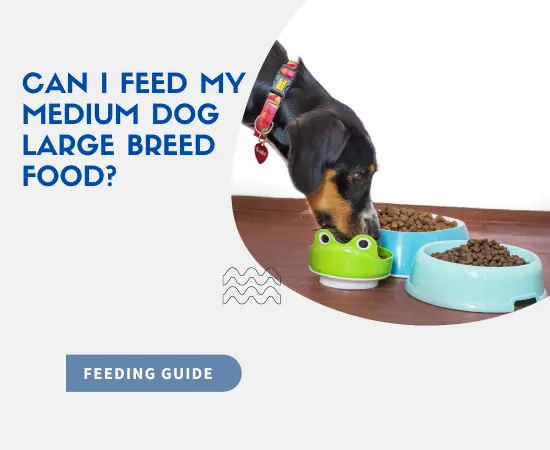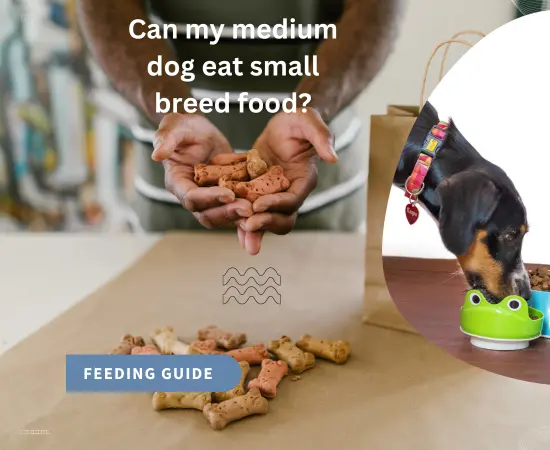This post may contain affiliate links. If you use these links to buy something we may earn a small commission. Thanks.
In the realm of pet care, understanding the dietary needs of our canine companions is pivotal. Different breeds and sizes of dogs have varying nutritional requirements, which is why there’s a spectrum of dog food types on the market. From breed-specific options to size-specific, grain-free, hypoallergenic, and beyond, choosing the right food for your dog can seem like a complex task. A common question that arises is whether or not a medium-sized dog can be fed large breed dog food. The answer isn’t as straightforward as it might seem, largely hinging on various factors, including breed size and individual health.
Understanding Dog Nutrition
Dogs, like humans, require a balance of proteins, carbohydrates, fats, vitamins, and minerals to function optimally. The proportion of these nutrients may vary based on a dog’s size, breed, age, and overall health condition. One fundamental aspect that distinguishes large breeds from medium or small breeds is their metabolic rates. Larger dogs generally have a slower metabolism compared to their smaller counterparts. This means they may require food with different calorie content to maintain a healthy weight.
Another crucial factor to consider is growth rates. Large breeds tend to grow quickly during their first year of life, and they continue to grow until they’re about two years old. In contrast, medium-sized dogs reach their adult size more quickly, typically by the time they’re a year old.
Differences between Large Breed and Medium Breed Dog Food
| Aspect | Medium Breed Dog Food | Large Breed Dog Food |
|---|---|---|
| Calorie Content | Typically higher per cup, as medium-sized dogs have faster metabolic rates than large breeds. | Generally lower per cup to prevent rapid growth and related health issues. |
| Protein Content | Balanced level to support general health and muscle development. | Similar levels of protein to medium breed food to support muscle development, but proportion might be slightly lower due to the overall lower calorie content. |
| Fat Content | Usually higher due to the higher energy needs of medium breeds. | Often lower to help prevent obesity and rapid growth that can lead to bone and joint problems. |
| Kibble Size | Medium-sized kibble to match the jaw size and bite force of medium-sized dogs. | Larger kibble size to encourage slower eating and to match the larger mouth and bite force of large breed dogs. |
| Special Additives | May contain general supplements for overall health. | Often includes additional supplements like glucosamine and chondroitin for joint health, as large breeds are more prone to joint issues. |
Please note that individual brands and formulations may vary, so always check the specific nutritional information on the dog food package and consult with a veterinarian to ensure you’re choosing the best food for your pet’s specific needs.
There are distinctive features when comparing large breed dog food with that of medium breeds. These variations cater to the different nutritional needs and physical attributes of the different dog sizes.
Firstly, the nutrient profiles of large breed and medium breed dog food vary. Large breed dog food often contains less fat and fewer calories per cup to prevent them from growing too fast, which could lead to bone and joint problems. The protein levels, however, should be enough to support muscle development and maintenance.

The size of the kibble also differs. Large breed dog food is usually made with bigger kibble sizes to encourage slower eating, which can help prevent conditions like bloat, a life-threatening situation common in large breeds.
There might also be specific ingredients and supplements included to support the health of larger breeds. For example, large breed dog food often contains additional glucosamine and chondroitin for joint health.
Potential Risks of Feeding Medium Dogs with Large Breed Food
Feeding your medium-sized dog with large breed food can lead to various health risks. Firstly, due to the lower calorie content, your medium dog may not get the energy they need for their higher metabolic rates, which could lead to nutritional deficiencies. On the other hand, if your dog starts eating more to compensate for the lower calorie intake, it could lead to obesity.
The large kibble size can also pose a problem. Medium dogs might struggle to chew the larger pieces, which could lead to choking hazards or dental problems. There’s also a chance that your dog could develop unhealthy eating behaviors, such as eating too quickly because they’re not accustomed to the larger kibble size.
The Importance of Consulting a Vet
When considering any changes to your dog’s diet, it’s essential to consult a vet. Veterinarians have an in-depth understanding of animal nutrition and can provide advice tailored to your pet’s specific needs, considering factors like their age, weight, activity level, and overall health status.
Dogs, like humans, have individual dietary needs, and what works for one dog might not work for another. Your vet can help you navigate these nuances to ensure your dog is getting a balanced and suitable diet.
Does dog size matter for dog food?
Yes, a dog’s size does matter when it comes to choosing the right dog food. Different sizes of dogs have different nutritional needs, metabolic rates, and physical characteristics that influence their dietary requirements.
1. Nutritional Needs: Larger dogs generally require fewer calories per pound compared to smaller dogs due to their slower metabolic rates. Feeding a small breed dog a large breed diet could lead to undernourishment, while feeding a large breed dog a small breed diet could result in overnourishment and potential obesity.
2. Metabolic Rates: Small dogs typically have faster metabolic rates and burn off energy more quickly than larger breeds, which is why their diet often needs to be higher in calories and fats.
3. Physical Characteristics: Even the physical characteristics of dogs, such as the size of their mouth and teeth, matter when choosing dog food. The kibble size varies in dog foods designed for different sizes of dogs, ensuring it is suitable and safe for them to eat and chew.
4. Growth Rates and Lifespan: Large breed puppies grow more slowly than small breed puppies, and they can continue growing until they’re nearly two years old, requiring a diet supporting this extended growth period. In contrast, small breed dogs typically reach their adult size much faster and require a diet that’s formulated to support their rapid growth.
Lastly, some large breeds are more prone to certain health conditions, such as joint issues, and some dog foods designed for large breeds will include additional nutrients like glucosamine and chondroitin to support joint health.
Can regular dogs eat large breed food?
Regular, or medium-sized, dogs can technically eat large breed food, but it may not be the best option for their health due to the different nutritional requirements of large and medium breeds. Large breed food is specifically formulated with a balance of nutrients tailored to the size, metabolic rate, and growth patterns of larger dogs. It generally has less fat and fewer calories per cup to prevent rapid growth, which could lead to bone and joint problems in large breeds. The kibble size is also typically larger to encourage slower eating and prevent conditions like bloat, common in larger breeds.
Feeding your medium-sized dog large breed food could lead to various potential issues. For instance, the lower calorie content may not provide sufficient energy for medium-sized dogs, who typically have a higher metabolic rate than larger dogs. Conversely, if your dog starts eating more to compensate for the lower calorie intake, they could risk becoming overweight or obese. Additionally, the larger kibble size may not be suitable for a medium dog’s smaller mouth, posing potential choking hazards and dental problems. Therefore, it’s generally recommended to feed your dog food that’s formulated for their specific size, and if considering any changes to their diet, it’s always best to consult with a veterinarian.

Can my medium dog eat small breed food?
While a medium-sized dog could technically consume small breed dog food, it’s generally not advised. Small breed dog food is specifically formulated to cater to the nutritional needs of small dogs. It often has higher levels of protein and fat to meet their faster metabolic rates. This could potentially lead to weight gain in a medium-sized dog if not properly monitored.
The kibble size of small breed food is also designed to be smaller to accommodate the mouth size and bite force of a small dog. Medium dogs can handle larger kibble, and feeding them smaller kibble might not only be unsatisfying for them, but it may also promote faster eating, potentially leading to issues like choking or gastric dilatation-volvulus (bloat).
To ensure your medium-sized dog receives the right balance of nutrients for their size, it’s best to choose a food specifically designed for medium-sized dogs. Always consult your vet before making significant changes to your dog’s diet. They can provide the best advice based on your pet’s unique needs and health status.
Conclusion
In conclusion, while it might be tempting to feed your medium-sized dog large breed food, perhaps due to convenience or economic reasons, it may not be the best choice for their health. The differences in nutrient content, kibble size, and specific ingredients could lead to potential health issues.
Ensuring that your dog gets the right food based on their specific needs is a key aspect of responsible pet ownership. As always, before making any significant changes to your dog’s diet, it’s crucial to consult with a veterinarian. They can provide expert guidance to ensure your furry friend stays healthy, active, and content.


